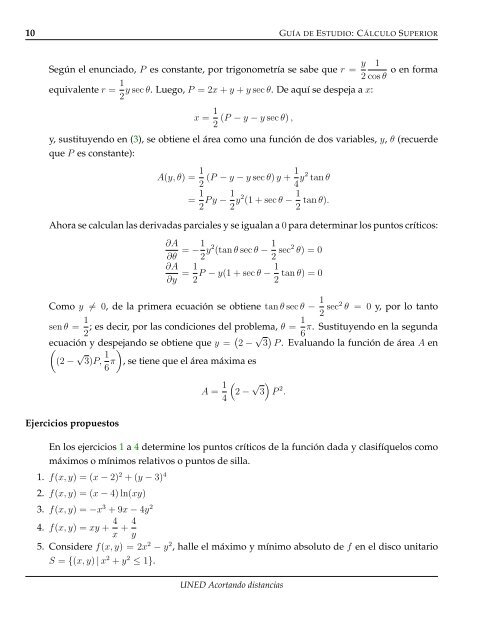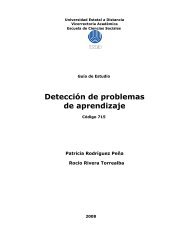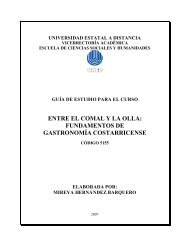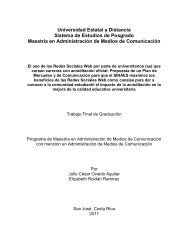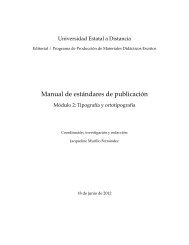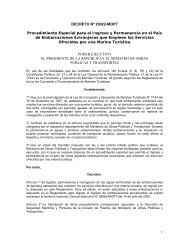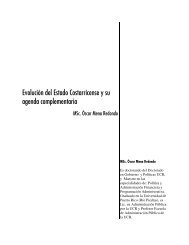GE3011 Cálculo Superior - Repositorio de la Universidad Estatal a ...
GE3011 Cálculo Superior - Repositorio de la Universidad Estatal a ...
GE3011 Cálculo Superior - Repositorio de la Universidad Estatal a ...
You also want an ePaper? Increase the reach of your titles
YUMPU automatically turns print PDFs into web optimized ePapers that Google loves.
10 GUÍA DE ESTUDIO: CÁLCULO SUPERIOR<br />
Según el enunciado, P es constante, por trigonometría se sabe que r = y<br />
2<br />
equivalente r = 1<br />
y sec θ. Luego, P = 2x + y + y sec θ. De aquí se <strong>de</strong>speja a x:<br />
2<br />
x = 1<br />
(P − y − y sec θ) ,<br />
2<br />
1<br />
cos θ<br />
o en forma<br />
y, sustituyendo en (3), se obtiene el área como una función <strong>de</strong> dos variables, y, θ (recuer<strong>de</strong><br />
que P es constante):<br />
A(y, θ) = 1<br />
1<br />
(P − y − y sec θ) y +<br />
2 4 y2 tan θ<br />
= 1 1<br />
P y −<br />
2 2 y2 (1 + sec θ − 1<br />
tan θ).<br />
2<br />
Ahora se calcu<strong>la</strong>n <strong>la</strong>s <strong>de</strong>rivadas parciales y se igua<strong>la</strong>n a 0 para <strong>de</strong>terminar los puntos críticos:<br />
∂A<br />
∂θ<br />
∂A<br />
∂y<br />
= −1<br />
2 y2 (tan θ sec θ − 1<br />
2 sec2 θ) = 0<br />
1<br />
1<br />
= P − y(1 + sec θ − tan θ) = 0<br />
2 2<br />
Como y = 0, <strong>de</strong> <strong>la</strong> primera ecuación se obtiene tan θ sec θ − 1<br />
2 sec2 θ = 0 y, por lo tanto<br />
sen θ = 1<br />
1<br />
; es <strong>de</strong>cir, por <strong>la</strong>s condiciones <strong>de</strong>l problema, θ = π. Sustituyendo en <strong>la</strong> segunda<br />
2 6<br />
ecuación y <strong>de</strong>spejando se obtiene que y = 2 − √ 3 <br />
P . Evaluando <strong>la</strong> función <strong>de</strong> área A en<br />
(2 − √ 3)P, 1<br />
6 π<br />
<br />
, se tiene que el área máxima es<br />
Ejercicios propuestos<br />
A = 1<br />
<br />
2 −<br />
4<br />
√ <br />
3 P 2 .<br />
En los ejercicios 1 a 4 <strong>de</strong>termine los puntos críticos <strong>de</strong> <strong>la</strong> función dada y c<strong>la</strong>sifíquelos como<br />
máximos o mínimos re<strong>la</strong>tivos o puntos <strong>de</strong> sil<strong>la</strong>.<br />
1. f(x, y) = (x − 2) 2 + (y − 3) 4<br />
2. f(x, y) = (x − 4) ln(xy)<br />
3. f(x, y) = −x 3 + 9x − 4y 2<br />
4. f(x, y) = xy + 4 4<br />
+<br />
x y<br />
5. Consi<strong>de</strong>re f(x, y) = 2x2 − y2 , halle el máximo y mínimo absoluto <strong>de</strong> f en el disco unitario<br />
S = {(x, y) | x 2 + y 2 ≤ 1}.<br />
UNED Acortando distancias


